-
Par trichard le 2 Février 2010 à 09:34Émilie Auvrouin
Dans les profondeurs de l'océan Indien, un gastéropode a trouvé une parade pour se protéger des prédateurs. Sa coquille, en partie constituée de fer, lui sert de bouclier.
Il y a quelques années, Christine Ortiz et ses collègues, du Département des sciences de l'ingénieur à l'Institut de technologie du Massachusetts (MIT), aux États-Unis, ont découvert lors d'une expédition au large de l'Océan Indien une nouvelle espèce de gastéropode. Ce mollusque, Crysomallon squamiferum, évolue à 2400 mètres de profondeur près d'une source hydrothermale, un « fumeur noir ». Inutile de dire que les conditions de vie y sont rudes (milieu acide, température de 200 à 300°C, et… attaques de prédateurs). La particularité de cet escargot est de posséder une coquille très résistante, bien plus que celle des autres gastéropodes. La même équipe de chercheurs vient de percer le secret de cette armure.
Pour survivre dans un environnement hostile, les animaux marins développent des stratégies de défense innovantes ; camouflage, poison, armes (piques, épines, etc.) et armure sont autant de moyens d'échapper au danger. Crysomallon squamiferum a développé une cuirasse protectrice, qui non seulement résiste à l'acidité de son habitat naturel, capable de dissoudre une coquille en carbonate de calcium, mais aussi aux attaques des prédateurs. Ainsi il échappe au crabe Brachyura équipé de deux pinces puissantes, ou à un escargot de mer carnivore de la famille des cônes, dont la dent en forme de harpon permet d'injecter une neurotoxine paralysante.
Pour comprendre la résistance du gastéropode, les chercheurs se sont dans un premier temps intéressés à la composition et à la structure de sa coquille. Dans un second temps, ils l'ont soumise à des tests de résistance mécanique par simulation numérique. L'atout de cette coquille est de dissiper efficacement l'énergie transmise lors d'une attaque grâce à sa structure unique, composée de trois couches superposées.
La couche la plus interne, classique puisque présente chez tous les gastéropodes, est faite de carbonate de calcium – une charpente qui structure l'ensemble de la coquille. Au milieu, une couche organique, plutôt molle, absorbe une partie de l'énergie transmise ; elle fait office de bouclier thermique, et, en outre, elle empêche la dissolution de la couche interne. Mais la plus étonnante des trois est la couche externe : elle est constituée de granules de sulfure de fer, dont les composants sont puisés dans l'environnement du mollusque. Lorsqu'un crabe tente de percer la couche externe, des microfractures se créent et de petites déformations l'empêchent de se briser totalement.
Ainsi, grâce à l'association de divers matériaux, organiques et inorganiques, ce gastéropode parvient à déjouer les attaques. Ces matériaux hybrides pourraient trouver des applications dans des secteurs où la résistance mécanique est un enjeu crucial : l'aéronautique, l'aérospatial, les équipements sportifs, etc.
http://www.pourlascience.fr/ewb_pages/a/actualite-un-escargot-dur-comme-fer-24211.php


 © Christine Ortiz (MIT)
© Christine Ortiz (MIT)
Coquille du gastéropode Crysomallon squamiferum, une espèce récemment découverte dans une source hydrothermale de l'océan Indien.
L'auteur
Émilie Auvrouin est journaliste à Pour la Science.Pour en savoir plus
H. Yao et al., Protection mechanisms of the iron-plated armor of a deep-sea hydrothermal vent gastropod, PNAS, vol. 107(3), 987-992, 2010. votre commentaire
votre commentaire
-
Par trichard le 28 Janvier 2010 à 16:49
Fossil feathers reveal dinosaurs' true colours
Pigment-storage sacs found in fossils give hints about hue.
http://www.nature.com/news/2010/100127/full/news.2010.39.html
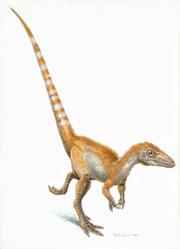 Sinosauropteryx may have had orange feathers and a stripey tail.Jim Robbins
Sinosauropteryx may have had orange feathers and a stripey tail.Jim RobbinsPristine fossils of dinosaur feathers from China have yielded the first clues about their colour.
A team of palaeontologists led by Michael Benton of the University of Bristol, UK, and Zhonghe Zhou of the Institute of Vertebrate Paleontology and Paleoanthropology in Beijing, has discovered ancient colour-producing sacs in fossilized feathers from the Jehol site in northeastern China that are more than 100 million years old.
These pigment-packed organelles, called melanosomes, have only been found in fossilized bird feathers before now.
The team discovered the melanosomes in fossils of the suborder Theropoda, the branch of the dinosaur family tree to which the flesh-eating species Velociraptor and Tyrannosaurus belong. However, it was not in these two iconic dinosaurs that the organelles were found, but in smaller species that ran around low to the ground with tiny feathers or bristles distributed across their bodies.
The team discovered two types of melanosome buried within the structure of the fossil feathers: sausage-shaped organelles called eumelanosomes that are seen today in the black stripes of zebras and the black masks of cardinal birds, and spherical organelles called phaeomelanosomes, which make and store the pigment that creates the rusty reds of red-tailed hawks and red human hair.
The team didn't find cell structures or machinery responsible for other colours, such as yellows, purples and blues. They suggest that dinosaur cells might have produced coloured pigments such as carotenoids and porphyrins, but that the proteins that make them degrade more rapidly than organelles, so do not leave a trace in fossils. Melanosomes, by contrast, are an integral part of a feather's tough protein structure so can survive for longer.
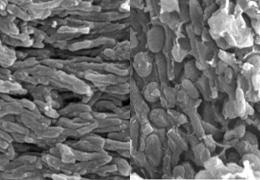 The team found pigment-storing eumelanosomes (left) and phaeomelanosomes (right) in the fossil feathers.University of Bristol.
The team found pigment-storing eumelanosomes (left) and phaeomelanosomes (right) in the fossil feathers.University of Bristol."We always tell introductory palaeontology students that things like sound and colour are never going to be detected in the fossil record," says Benton. "Obviously that message needs to be reconsidered."
Fossils of one theropod dinosaur, Sinosauropteryx, reveal that it had light and dark feathered stripes along the length of its tail. The team found that feathers from the darker regions of the tail were packed with phaeomelanosomes, indicating they were russet-orange in colour. The lighter stripes could have been white, says Benton, but because some pigments degrade and don't leave a fossil signature, it is difficult to be sure.
Sinosauropteryx was not the only colourful feathered species. Another small theropod species, Sinornithosaurus, had feathery filaments that were dominated by either eumelanosomes or phaeomelanosomes, hinting that its individual feathers varied in colour between black and russet-orange.
Birds of a feather
A lot of questions have been raised about the structures that are found on the earliest of the feathered dinosaurs, such as Sinosauropteryx. Some palaeontologists argue that these bristle-like structures are actually fossilized connective tissue rather than early feathers.
However, says Benton, in modern birds — which evolved from the theropod dinosaurs — melanosomes are found only in the developing feathers and not in the connective tissue. The fact that the melanosomes in the dinosaur feathers are also found inside the bristles themselves resolves the debate, he says.
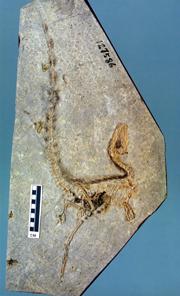 Samples were taken from a dark stripe near the base of Sinosauropteryx's tail.The Nanjing Institute
Samples were taken from a dark stripe near the base of Sinosauropteryx's tail.The Nanjing Institute"This paper puts the nails in the coffin of arguments countering the feather nature of these structures," agrees Luis Chiappe, a palaeontologist at the Natural History Museum of Los Angeles County, California.
"It is deeply gratifying that this colour discovery is allowing us to finally agree that the structures on Sinosauropteryx were actually early feathers," says evolutionary ornithologist Richard Prum of Yale University in New Haven, Connecticut. "Now we can get on with studying their evolution."
In addition, the discovery of colour in the earliest feathers may also sway the biggest dinosaur debate of them all — what the feathers were actually being used for.
The tiny bristles on early feather-bearers could not have been used for flight, as some have suggested, because they would have provided no lift. But they could have served as insulation, or for display.
"It is looking increasingly likely to me that these dinosaurs were making a visual statement," says Benton. "What that statement was, we don't know, but you don't have a orange-and-white striped tail for nothing."
 votre commentaire
votre commentaire
-
Par trichard le 25 Janvier 2010 à 17:20
Climate not to blame for the extinction of Australia's big animals.
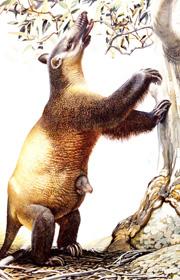 The half-tonne Palorchestes azael may have been exterminated by the activity of early humans.Peter Schouten
The half-tonne Palorchestes azael may have been exterminated by the activity of early humans.Peter SchoutenHumans, not climate change, caused the mass extinction of Australia's giant animals, such as huge kangaroos, tens of thousands of years ago.
Scientists have long argued over what killed off about 50 species of animals weighing more than 45 kilograms, including the gigantic kangaroo, Procoptodon, and the two-tonne wombat-like marsupial Diprotodon, late in the Pleistocene epoch, which stretched from 2.6 million until about 12,000 years ago.
Some have proposed that the ancestors of Australian Aborigines, who reached the continent between 60,000 and 45,000 years ago, rapidly hunted the animals to extinction. Others have argued for environmental disruption from human-lit fires — a 'slow burn' to extinction as people set the bush alight to clear pathways or flush out prey, altering the continent's vegetation, hydrology and climate. In the climate change camp are scholars who blame the most recent Ice Age, which peaked about 21,000 years ago.
Temporal overlap?
Evidence for a human cause has been mounting over the past decade. One study dated the extinction of the 2-metre-tall, 200-kilogram flightless bird Genyornis to about 50,000 years ago, soon after human colonization, and at a time when the climate was benign1. That work, on the bird's eggshell, was later backed up by a coast-to-coast project dating the extinction of giant marsupials, reptiles and birds across the continent to about 46,000 years ago2.
However, one site, Cuddie Springs in New South Wales, has been held up as evidence for a long overlap between humans and megafauna, seemingly clearing people of being the main agents of the extinction of the animals. It is the only site with megafauna remains and Aboriginal artefacts in the same sedimentary layers. Those layers had been dated by radiocarbon and luminescence methods to between about 40,000 and 30,000 years old.
But some researchers doubted the results, which dated the megafauna only indirectly, through charcoal and sand grains in the layers bearing the fossils and stone tools. They said the site had been disturbed, with megafauna fossils from older deposits working their way into younger deposits. Lacking the protein collagen, the bones could not be dated directly by the radiocarbon method.
Dating discrepancy
Now a team led by Rainer Grün, a geochronologist at the Australian National University in Canberra, has used electron spin resonance (ESR) and uranium-series techniques to date the megafauna teeth directly. Their laboratory is the only one in Australia — and one of only a few worldwide — using ESR in this way.
All of the specimens of extinct species are at least 50,000 years old, some much older, the team reports in a paper in press with Quaternary Science Reviews3. The results debunk claims of the late survival of the giant animals and a long period of coexistence between them and people. The findings weaken arguments for climate change as the main cause of the demise of the megafauna.
But they do not discriminate between the two possible mechanisms of the catastrophe — rapid 'blitzkrieg' and slow burn — because the date of colonization and the date of extinction are not known with sufficient precision.
"Our results eliminate a strong argument against the blitzkrieg hypothesis but do not prove it," says Grün.
Richard Roberts, a geochronologist at the University of Wollongong, Australia, and biologist Barry Brook, of the University of Adelaide, Australia, say in a commentary4 in Science that "human impact was likely the decisive factor", possibly through hunting of young megafauna. Increased aridity during the last Ice Age might have reinforced this effect, but Australian megafauna were well adapted to dry conditions because they had survived repeated droughts in the past, they say.
Chris Johnson, an ecologist at James Cook University in Townsville, Australia, says the direct dates from Cuddie Springs mean the site now "falls in line with a mass of other evidence" for the rapid extinction of the Australian megafauna between 50,000 and 40,000 years ago.
Archaeologist James O'Connell of the University of Utah says the jury is still out. O'Connell, who has worked extensively in Australian archaeology — including on the Cuddie Springs site, says there might have been a long period of overlap between megafauna and people, regardless of which Cuddie Springs dates are correct. "Climate may not be the only factor, but it can't be eliminated as a significant consideration," he says.
-
References
- Miller, G. H. et al. Science 283, 205-208 (1999). | Article | PubMed | ISI | OpenURL | | ChemPort |
- Roberts, R. G. et al. Science 292, 1888-1892 (2001). | Article | PubMed | ISI | OpenURL | | ChemPort |
- Grün, R. et al. Quat. Sci. Rev. advance online publication doi:10.1016/j.quascirev.2009.11.004 (2009).
- Roberts, R. G. & Brook, B. W. Science 327, 420-422 (2010). | Article | PubMed | OpenURL
http://www.nature.com/news/2010/100123/full/news.2010.30.html
 1 commentaire
1 commentaire
-
-
Par trichard le 25 Janvier 2010 à 17:17
 Reconstitué, consolidé, méticuleusement analysé, Ardipithecus ramidus, vieux de 4,4 millions d'années, nous amène aujourd'hui à réécrire en partie l'histoire de l'évolution de l'Homme et du chimpanzé, notre plus proche parent vivant.
Reconstitué, consolidé, méticuleusement analysé, Ardipithecus ramidus, vieux de 4,4 millions d'années, nous amène aujourd'hui à réécrire en partie l'histoire de l'évolution de l'Homme et du chimpanzé, notre plus proche parent vivant.Depuis une quinzaine d'années, régulièrement, nous interrogions Tim White, de l'université de Californie : présenterait-il bientôt les fossiles exceptionnels d'hominidés qu'il avait découverts, avec son équipe, en Ethiopie ? Accepterait-il d'en parler ? Ces paléoanthropologues avaient en effet créé en 1995 l'espèce Ardipithecus ramidus, à partir de fragments osseux et de dents datés de 4,4 millions d'années. C'était à l'époque le plus ancien hominidé connu. Et, dans les années suivantes, l'information avait diffusé dans le cercle des spécialistes : la même équipe avait également retrouvé un squelette très complet de la même espèce. Mais, imperturbablement, Tim White répondait à chaque fois que les restes étaient très fragmentés, très fragiles, que son équipe devait encore travailler, et qu'il était trop tôt pour en dire quoi que ce soit.
Notre patience a été récompensée : dans le numéro de février de La Recherche, Tim White et ses collègues présentent Ardi, le squelette d'hominidé ancien le plus complet connu. Le crâne et sa denture, les avant-bras, les mains, le bassin, une jambe et les pieds : il est plus complet que la célèbre Lucy, trouvée en 1974 à Hadar, 75 kilomètres plus au Nord. Trois mois après la publication scientifique pour les spécialistes, dans un épais dossier de la revue scientifique américaine Science, il nous a en effet semblé nécessaire de refaire le point sur ce que nous savons (et sur ce que nous ne savons pas) de l'histoire de l'homme et de ses ancêtres.
Car les informations apportées par l'analyse du squelette d'Ardi, des restes de 36 de ses congénères retrouvés dans le même secteur et de tous les éléments de faune et de végétation fossiles qui les accompagnaient obligent les paléontologues à reconsidérer les premières étapes de l'histoire des hominidés. Ardi, en particulier, apporte un éclairage nouveau sur l'émergence de la bipédie. Celle-ci aurait été favorisée par le comportement social, les mâles transportant de la nourriture afin de la partager avec les femelles, plus que par l'environnement, comme beaucoup le pensaient.
Luc Allemand
http://www.larecherche.fr/content/actualite-Vie/article?id=27175
 votre commentaire
votre commentaire
-
Par trichard le 19 Janvier 2010 à 20:58
Rare sighting of brown-and-white panda sparks conservation debate.
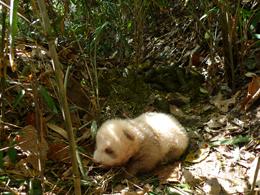 This rare panda cub with brown-and-white fur could carry genetic clues about the species' inbreeding.Qihui Liang
This rare panda cub with brown-and-white fur could carry genetic clues about the species' inbreeding.Qihui LiangPandas are increasingly endangered in the wild, and the sighting of one with extremely rare brown-and-white fur is now raising fears that the species may be suffering from inbreeding.
In November 2009, a staff member at the Foping Nature Reserve in China's Qinling Mountains — one of the panda's last remaining strongholds — spotted a panda with the unusual colouring. It was estimated to weigh around 2 kilograms, which would suggest it was less than 2 months old at the time.
This is only the seventh such animal spotted in the region over the past 25 years, says Tiejun Wang, a spatial ecologist in the Department of Natural Resources at the University of Twente in Enschede, the Netherlands, who has worked in Foping for two decades. But the explanation for this unusual variety remains a mystery. "It's time we had a debate about what is causing this because it could be telling us something very important," he says.
Wang and his Twente colleague Andrew Skidmore are concerned that the brown-and-white form indicates that breeding between closely related pandas is becoming more common.
Each panda has two versions, or alleles, of each of its genes, one inherited from its mother and one from its father. Wang suggests that the Qinling pandas carry a dominant gene for black fur and a recessive gene for brown fur. This means that pandas with brown-and-white fur are only possible when they inherit the recessive brown gene from both mother and father.
The chances that both parents have the brown allele are ordinarily very low, suggests Wang. But the coincidence would be much more likely if the pandas were closely related. "The habitat in the Qinling Mountains is seriously fragmented and the population density is very high," says Wang. "The brown pandas could be an indication of local inbreeding."
Conservationists worry about such inbreeding because it means that more animals rely on the same set of genetic defences to overcome environmental threats, increasing their risk of extinction.
Genetic analysis
According to Wang, brown-and-white pandas have only been seen in the Qinling population, one of five mountain regions where pandas still live in the wild. Qinling is home to around 300 animals, roughly one-sixth of the total panda population in the wild.
The first recorded brown-and-white panda — a female called Dan-Dan — was discovered in 1985. She was taken into captivity, mated with a black-and-white animal and gave birth to a normal black-and-white male. A few years later, another brown-and-white panda was seen in the wild, together with its black-and-white mother. "These anecdotal observations strongly suggest the presence of a recessive gene or genes," says Wang.
The idea is worth investigating, says Sheng-guo Fang, a researcher at Zhejiang University in Hangzhou, China, who has studied the morphology and genetics of the Qinling pandas. But there could be other factors at play, he cautions.
Fang and colleagues have found that, although most of the Qinling pandas appear to be normal black-and-white animals, many of the region's pandas do have touches of brown in their chest fur1. This suggests that there could be something specific to Qinling, such as the climate or a particular environmental chemical, that affects one or more pigmentation genes, says Fang. "The Qinling Mountains have shaped brown subspecies of other mammals, such as the golden takin," he notes.
The idea of inbreeding in Qinling is also at odds with the most recent genetic analyses, which show that despite a dramatic contraction of the panda's range over the past few thousand years, the remaining giant panda populations seem to have retained a lot of genetic diversity2. "The evidence that giant pandas in general, and in the Qinling Mountains in particular, are of low genetic variation is at best equivocal," says Mike Bruford, a molecular ecologist at Cardiff University, UK, who worked on that study2.
The giant panda genome, which was published online in Nature last month3, also revealed little sign of inbreeding, says Jun Wang of the Beijing Genomics Institute in Shenzhen, China. But the genome is likely to prove invaluable for solving the mystery of the brown pandas of Qinling. "There are over 125 genes known to affect pigmentation in mice," says Hopi Hoekstra, an evolutionary biologist at Harvard University in Cambridge, Massachusetts, and an expert on pigmentation in mammals. "There are definitely a good handful of candidate genes you could sequence in the two morphs and look for differences," she says.
Jun Wang and his colleagues are already on the case. So far, they have studied the sequence of some 50 genes known to be involved in pigmentation. A comparison of brown and black pandas at Qinling and other sites should shed light on the genetic basis of this rare variety, he says.
- Wan, Q.-H., Wu, H. & Fang, S.-G. J. Mammal. 86, 397-402 (2005). | Article
- Zhang, B. et al. Mol. Biol. Evol. 24, 1801-1810 (2007). | Article | ChemPort |
- Li, R. et al. Nature advance online publication doi:10.1038/nature08696 (2009).
http://www.nature.com/news/2010/100118/full/news.2010.19.html
 votre commentaire
votre commentaire Suivre le flux RSS des articles de cette rubrique
Suivre le flux RSS des articles de cette rubrique Suivre le flux RSS des commentaires de cette rubrique
Suivre le flux RSS des commentaires de cette rubrique
Mon petit cahier de sciences naturelles





